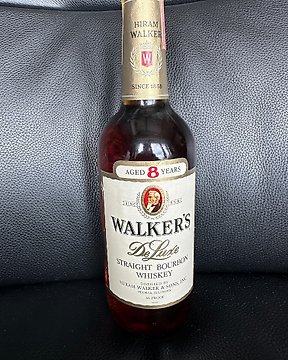
Walker's 8 years old - De Luxe - 86 Proof - b. década de 1970 - N/A
N.º 81907447

N.º 81907447

40 OZ.
ACQUISTATA IN ITALIA NEGLI ANNI 70 PRESSO BASE NATO
Tom Moore
BOTTIGLIA PARI AL NUOVO, PERFETTE CONDIZIONI
ETICHETTA
-EXPORT BOTTLE
-U.S. INTERNALREVENUE 608676844 TAX PAID
Sketch Photo of Tom Moore, provided by Barton/1792 web site
The "Kentucky Gentleman"
Thomas S. Moore was born in March 1853 in Nelson County, from his parents Charles A. Moore and Catherine (Kate) Ann Moore. The Moore family were descendants of an Irish family who had come west to Kentucky looking for a farm that was both fertile and inexpensive unlike back east. They moved to Bardstown, Kentucky where the first Catholic diocese was established west of the Appalachian Mountains.
Charles Moore died when Tom was only eleven years old and Tom had to drop out of formal schooling and join the workforce to help support his family. In 1870 he lived with his widowed mother, a brother and two sisters, one of them married to Charles Willett. The Willetts were of the oldest families in the Kentucky whiskey business and were extremely wealthy.
Chirip-Sirip-Leaderboard-Ad
His mother Kate died in 1872 and in 1874 Moore at the age of 22 married Mary Virginia (Jennie) Collings, who was 18 and the daughter of John and Mary Collings of Nelson County. That same year he went to work for the Willett family in its distilling business. There he met another new employee Ben Mattingly, they would go on to work closely together for years. Ben fell in love with one of the Willett sisters and he married her.
The leader of the Willett empire was John D. Willett, who owned a Louisville company called Willett & Frenke. That company operated a distillery at Morton’s Spring in just south of Bardstown. In 1876, Willett signed over ownership interest of the Willett & Frenke distillery to Tom and Ben (well, probably it was to their wives, his daughters legally). Tom and Ben were the ones that ran the show and operated the facility under the name “Mattingly and Moore.”
They made Mattingly & Moore bourbon, along with Belle of Nelson (named for John Willett's winning race horse) and Morton’s Spring Rye named after the limestone spring that the water came from to distill their whiskey.
Mattingly then sold his majority share the company to a group of investors. Tom Moore continued to work with the new company for eight years until 1899, when he bought 116 acres adjacent to the existing distillery and built his own distillery there, producing Tom Moore, Dan’l Boone, and Eleven Jones whiskey.
Upon leaving the company Tom did not go far, he purchased 116 acres of property less than a half mile from Bardstown city limits adjoining the original distillery that he just left. Moore built a new distillery with the help of Irish wholesaler from New York that wanted to cement a consistent supplier. Initially the plant could mash 100 bushels of grain daily, turning into ten barrels of whiskey a day. The distillery buildings were frame construction with a fire-resistant roof, surrounded by five warehouses. Some of those warehouse were made of brick, stone or iron-clad walls but all had fire-resistant roofs.
By 1900 he and Jennie had six children; Mary, Alice, Cornelius, Thomas, Margaret, and Lawson. As they grew into teenagers the boys would be hired into the business and assist the distillery managers.
In 1916 the company and investors that owned Mattingly & Moore went bankrupt, and the distillery was acquired by a Louisville company that was their chief distributor. Tom Moore, himself, later acquired that same property and incorporated it into his own distillery, tearing down the old buildings himself. The resultant site remains that of the Tom Moore distillery, now called the Barton/1792 Distillery.
Throughout these years, the Moore distillery flourished as his bourbon and other whiskeys gained a national following. Moore’s wealth allowed him to buy and operate The Old Talbott Tavern in Bardstown which was built in 1779 and is the oldest standing western stagecoach stop in America.
Thomas S. Moore age 67, maintained leadership of the company until it was closed by Prohibition in 1920 when he appears to have retired. Tom lived to see Prohibition repealed in 1934. At that time he and his son, Con, rebuilt and expanded Tom’s original distillery, giving it a mashing capacity of 2,400 bushels. Three new warehouses were built and had the capacity to store 50,000 barrels. Tom Moore died in 1937 in Bardstown at the age of 84 from bronchial pneumonia and was was buried in St. Joseph Cemetery beside his wife Jennie.
In 1944, Con sold the distillery to Oscar Getz, a Chicago liquor merchant. Getz changed the name to the Barton Distillery, a name he made up and "picked from a hat". They produced two brands of straight Kentucky bourbon, Tom Moore and Kentucky Gentleman. Under Getz's leadership the Barton Distillery company went on to become Barton Brands Limited. When Barton Brands purchased the Glenmore Distillery in Owensboro, Kentucky they made several new brands from that region including; Kentucky Tavern, Ten High, Walker’s Reserve and Imperial Blended Whiskey as well as Fleischmann’s Rye and several blended whiskies.
Como comprar na Catawiki
1. Descubra algo especial
2. Faça a licitação vencedora
3. Faça um pagamento seguro